
MAY CONTAIN NUTS

Search Shorpy
SHORPY ART

Framed or unframed, desk size to sofa size, printed by us in Arizona and Alabama since 2007. Explore now.
Join and Share
Ad-Free Shorpy
Shorpy is funded by you. Patreon contributors get an ad-free experience.
Learn more.

Recent comments
- Details, Details
- What's that building to the left of the tower?
- Coal Barges
- Bromo-Seltzer
- Inner harbor
- The Basin
- What a headache!
- Giant stepladder?
- Baldwin 62303
- Baldwin VO-1000
- Cold
- No expense spared
- Tough Guys
- Lost in Toyland
- And without gloves
- If I were a blindfolded time traveler
- Smoke Consumer Also Cooks
- Oh that stove!
- Possibly still there?
- What?!?
- $100 Reward
- Freeze Frame
- Texas Flyer wanted
- Just a Year Too Soon
- WWII -- Replacing men with women at the railroad crossing.
- Yes, Icing
- You kids drive me nuts!
- NOT An Easy Job
- I wonder
- Just add window boxes
Member Photos
The Shorpy
Print Emporium
Print Emporium
Search Shorpy
Search results -- 30 results per page
- Morning in Manhattan: 1900
- "New York City Hall and park, 1900." It's ten o'clock -- do you know where your great-grandparents are? 8x10 inch glass negative. View full size.
Not an aerial view but ....
Now named for a crook Behind City Hall is the ... Posted by Dave - 12/08/2015 - 12:43pm -
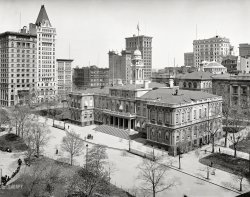
- Milled in Manhattan: 1910
- New York circa 1910. "Williamsburg Bridge and East River waterfront." With a cameo by the Heckers' Flour mill on Water Street. 8x10 glass negative, Detroit Publishing Co. View full size.
Not much wave action Water surface patterns indic ... Posted by Dave - 05/08/2020 - 1:22pm -
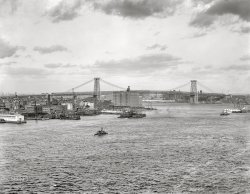
- 9/11: 1933
- ... ten-year old Yankee Stadium! Any idea?
Good Morning Manhattan Another gorgeous Gottscho image, thanks. If I had the time, I ... to state the obvious, I would wager that no one in that Manhattan of 1933 could possibly imagine the evil events that would occur on ... Posted by Dave - 07/31/2012 - 6:34pm -
![9/11: 1933 September 11, 1933. "New York City views. Looking north from the Empire State Building." 5x7 safety negative by Gottscho-Schleisner. View full size.
On a clear day........you can see Central Park! Nowadays, the view is blocked by skyscrapers. (A nice view of the park can still be had from The Top Of The Rock -- 30 Rockefeller Plaza.)
Bryant Park looks like a sand pit, which it sort of was in 1933-34, according to Wikipedia: http://en.wikipedia.org/wiki/Bryant_Park
I'm fascinated by what looks like a huge clearing on the Upper West Side -- west and slightly north of what I'm guessing is The Lake in Central Park. The clearing appears to start at Columbus Avenue, and extend all the way to Broadway.
Yankee Where?I can't see the ten-year old Yankee Stadium! Any idea?
Good Morning ManhattanAnother gorgeous Gottscho image, thanks. If I had the time, I would love to spend the day pinpointing which buildings are gone and which remain. New Jersey, as well as the east and west 90s and up, seem almost rural, though the newly-constructed George Washington Bridge is visible in the distance. Being the first here to state the obvious, I would wager that no one in that Manhattan of 1933 could possibly imagine the evil events that would occur on that day 68 years later, or, for that matter, the architectural extremes that the events would target. While many of these buildings in this absurd and wonderful city remain, our relative sense of innocence does not.
Names and AddressesOkay, New Yorkers, fill us in on some details!
SpookedIs that the spectre of Death haunting the roof of the building in the center foreground?
PeepyThat's a lot of windows. The city really is kind of a mess when viewed that way. It's as if somebody put together a jigsaw puzzle with their eyes closed. As much as some people complain about the coldness of modern glass and steel structures, they really do make for a better looking city when viewed as a whole.
Infant BridgeThe nearly two year old George Washington Bridge is in the background to the upper left.
What a sightThis is an incredible photo...as far as the eye can see. I would love to see the same scene today!
What a fantastic photo!Note how then then-new Waldorf Astoria and the original RCA building (which became the NY HQ for General Electric so after this time) just behind it stand out in this photo, looking to the northeast. 30 years later, that area along Park and Lexington Avenues became filled with tall buildings. Also it looks like Bryant Park was being rehabilitated at that time.
Keep the Gottscho coming!I could stare at this for hours.
Check out Bryant Park, which appears to be in the middle of its Robert Moses-led reconstruction, and the Sixth Ave. El station at the park's northwest corner.
In Central Park, just peeking out from behind the RCA Building, is what I believe to be the old Croton Lower Reservoir. Within a year or two from this photo, it would be filled in to create the Great Lawn.
See how comparatively un-built-up the island is beyond Central Park, especially around Morningside.
You can easily make out the Bronx County Courthouse, and that horizontal feature just to the right must be the 10-year-old Yankee Stadium. The GW Bridge pictured here has been open less than two years.
What's most tantalizing to me is the scene at upper left, where the Hudson curves away to lose the northern Westchester shoreline in the mist and pixels. That's where I grew up, and this photo shows it 35 years before I was born... except it really doesn't. Makes me wish I were on one of those TV shows where you can just stand in front of the computer and say "Enhance... enhance... enhance."
Knox KnowledgeLots about the Knox Hats guy (extreme foreground, right) here: http://www.time.com/time/magazine/article/0,9171,927954-2,00.html
Let's Start At The Bottom of the PictureThis is one busy shot. I'll be looking at it for weeks trying to identify the buildings still standing. I'll start now with the Lord and Taylor Flagship Store that occupies the block from 38th to 39th Streets on the west side of Fifth Avenue. The Empire State Building, the location from which the photo was made, is on 5th Ave. also on the west side of the street from 33rd to 34th Sts. In the case of the Lord and Taylor store, the building itself is probably worth more than the store. Rumors persist that they were about to develop the existing building into condos. The building was declared a landmark in 2007 so they can't tear it down, but they probably can build above it. The Ovington Store, to the right of Lord and Taylor in the picture, sold Fine China. That building has been replaced by a 55 story Condo known as 425 5th Ave., completed about 5 years ago.
WindowsFunny the poster who mentioned that there were a lot of windows (and disliked it). When I first looked at it I marvelled at all the wonderful windows - how human it looks - unlike the cold blank modern walls of glass.
My grandparents and my father and mother could be walking along one of those streets even as this picture was taken. In fact since my grandfather was a mailman, he probably was!
Where's my desk?If you look west across from 30 Rock (RCA/GE) Buidling, across Sixth Avenue, you see many low rise structures that are now occupied by the XYZ buildings built in the late 60's early 70's (Rock Centre West.) From 52nd street down to 47th street on 6th Ave.; 1271 6th, 1251 6th, 1221 6th & 1211 6th (where I'm sitting as I write this.) As a matter of fact, 6th Avenue has been so dramatically changed from those days with hi-rise office buildings lining the avenue fromCentral Park down to Bryant Park.
And another note about the windows... these buildings have much more character than the sleek glass towers. These buildings define a cityscape.
HoovervilleBy 1933 the reservoir had been drained, giving rise to a "Hooverville" (shantytown named after then-President Herbert Hoover). What you see are the walls of the former reservoir -- the Great Lawn wasn't completed until 1936.
No Triboro Bridge yet, just the Hellgate rail bridge (top right).
Wow!What a wonderful photo!
Thank you for sharing it.
A few detailsJust in front of the GW Bridge, the tower sticking up is Riverside Church, completed in 1930, to the right of that you can sort of make out the side of the Cathedral of St John the Divine. To the left of Bryant Park is the 6th Avenue El, which was torn down in the 1950's. The low buildings along the left side of 6th Ave all got knocked down at the same time to make the new Avenue of the Americas (which New Yorkers still call 6th Avenue), and the long line of the 50-plus-story office buildings spawned by Rockefeller Center.
Right behind and between the towers of the Waldorf Astoria is the tower of the old GE Building, one of the most gorgeous Deco spires ever built. In front of Bryant Park the dark tower is the Radiator Building, made famous by Georgia O'Keeffe. Just below Central Park, and just below the roofed tower of the Essex House, you can see the dome of what eventually became the New York City Center.
Oh, and in the upper right corner the grand old Hellgate Bridge, the only object in this picture ever reproduced by the Lionel Train company.
Air conditioningThis was pre-air conditioning, it must have been sweltering in those offices. Probably the days when windows could be opened though. When was air conditioning in office towers introduced?
[Generally speaking, the 1930s. Individual room coolers at first. - Dave]
Similar view from 2000Here's a shot I took in October 2000 from roughly the same place looking roughly the same direction (with an Epson 850Z 2MP digital camera). I've sized and distorted it to roughly match the Gottscho.
Have fun!
HouseThat Ruth BuiltMy guess is that the Stadium is about here:
Twenty days after this picture was taken, the Babe did something notable here. Any takers?
Ford FactoryOn the Jersey side, south of the bridge. The large multi- story building on the bank of the river. I believe it to be the Edgewater Ford assembly plant whose output was mostly export.
Crystal clearAmazing that you can't see the air.
Yankee StadiumForeshortening at the top of the photo makes it very hard to see. Follow Fifth Avenue (on the right side of Central Park) up to the end. The stadium appears as a low, wide structure positioned just to the left and just past the end of Fifth. It seems to be partially blocked by something but I can't make out what the something is. Or that might be reflected sunlight from the southern facade of the stadium, given the angle of the sun in the photo.
Break the number 7 into two pieces, a horizontal and a vertical : -I
Yankee Stadium is the horizontal, 5th Ave is the vertical.
Enhance! Enhance!
Babe Ruth RecordIn his last pitching appearance on 1 October 1933, Ruth tallied 10 winning seasons in 10 years as a pitcher, a record unmatched until 2004.
Still StandingAlthough the New York skyline has changed much in the past 76 years many of these buildings are still standing and still prominent. On one level there are the monumental buildings such as the Public Library, St. Patricks, Grand Central Station, and the Metropolitan Museum of Art. All built with a confidence in permanence and hisory. And all horizontal. The later buildings seen here reach for the sky. Conceived in the boom of the Twenties they withstood the Depression (when this photograph was taken) and still stand tall; not too far from where we are today. A quick blink in time. Let's wait for the picture from 2085.
New Yorker hereI used to work in the Empire State Building. There may be air conditioning in individual offices, but it is also possible to open the windows. The story goes that if you jump out of them the updrafts will blow you back into another open window. Supposedly this happened once.
It's a lovely building and everyone who worked there was proud to be there. I noted the office of F. Lee Bailey just down the hall from the T shirt company I was working for. "Yes, you can hire him if we don't pay your bill," they joked.
Stork ClubMy dad was born somewhere down there, exactly one month later that same year. I'll have to show this to him. He'll get a kick out of it, since he's only been back to the city once -- in 1988.
(The Gallery, Gottscho-Schleisner, NYC)](https://www.shorpy.com/files/images/05850u.thumbnail.jpg)
- The Bowery: 1900
- ... A tree grows in Brooklyn But not in the Bowery.
The Manhattan Bridge of 1909 took care of the buildings on the immediate right. ... side) of Bowery ends at 77 and picks up at 25 south of the Manhattan Bridge entrance. Thanks again Dave for these wonderful photos!
... Posted by Dave - 08/01/2012 - 5:36pm -
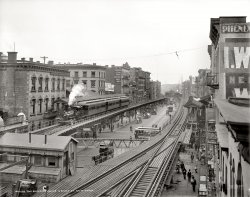
- Italian Grocery: 1943
- ... New York. Italian-Americans on the Lower East Side of Manhattan. Italian grocery store owned by the Ronga brothers on Mulberry ... Posted by Dave - 02/25/2024 - 7:31am -
![Italian Grocery: 1943 January 1943. "New York, New York. Italian-Americans on the Lower East Side of Manhattan. Italian grocery store owned by the Ronga brothers on Mulberry Street." Acetate negative by Marjory Collins for the Office of War Information. View full size.
I'll have a half pound of prosciutto crudoMulberry, running north and south, is not a particularly long street. Today, the very southern end is inside Chinatown. But, as you cross Hester Street, you are back in the Ronga Brothers' old neighborhood.
Cheese WheelsIs that cheese Extra Shorpy?
Mert's meat marketWhere I grew up in Pennsylvania there was the same sparkling white scale and aproned owner. Oh, the smell and the doorbell tinkling. What a simpler time.
A Borsalino or a fedora?Actually it could be both, since the Borsalino company, with its trademarked eponymous hat, also makes fedoras. I stand to be corrected, but I'd say Signore Ronga's is a fedora, prized for brims that can be adjusted up or down, or both, for your signature look.
TechniqueLooks like three flashbulbs -- one is showing, clamped to that high shelf. Wonder if anyone in the world can do that kind of location shooting nowadays, and have it come out this perfectly. Wonder how consistently she could do it.
[Floodlights. - Dave]
Ah -- so those are the power cords running up to the visible light. That makes more sense.
I didn't see nobodyMaybe your boys came in here, and maybe they didn't.
Oh those Italians!Talking with their hands. Not to be stereotyping or anything.
Isn't this the bakery?No sir, you have the Ronga address.
The EffluviaIs somewhat obnoxious to those walking into that establishment. I would imagine those who may not be familiar with all the odors coming from the rafters it would seem overwhelming to their senses.
But I will have some prosciutto please!
The President's BirthdayJust noticed the counter card for the March of Dimes celebrating the president's birthday. Interesting that everyone was apparently aware that FDR had polio even though they never showed him on crutches or in a wheelchair.
Re: Effluvia, or "And to Think That I Saw It on Fourth Street!"Are you kidding?!?
This photo is a dead ringer for Arrigoni's Market (long gone) in my home town.
I can still smell that wonderful mix of meats and cheeses, along with the amazing clutter of "exotic" deli and packaged items.
I long for anything remotely like this in modern California (south Bay Area)!
(The Gallery, Marjory Collins, NYC, Stores & Markets)](https://www.shorpy.com/files/images/SHORPY-8d12273u.thumbnail.jpg)
- Camels: 1943
- ... things that bring a photo to life. View full size.
Manhattan Fruit Drinks & Skirts What first caught my eye was the corner ... offering "Papaya" drinks--this in 1943. As a child in Manhattan in the 1950s I remember visiting fruit drink stands with my ... Posted by Avzam - 10/16/2011 - 9:59pm -
![Camels: 1943 Another Times Square photo from 1943 by John Vachon, colorized. I hope you all enjoy this one as much as I did. Note the lights left on on the second floor. These are the small things that bring a photo to life. View full size.
Manhattan Fruit Drinks & SkirtsWhat first caught my eye was the corner store in Times Square offering "Papaya" drinks--this in 1943. As a child in Manhattan in the 1950s I remember visiting fruit drink stands with my father--he enjoyed them. Later, I thought the ubiquitous fruit drink stands were a dividend of the Puerto Rican invasion of Manhattan. But maybe NYC was always in favor of fruit juice.
Also, note how abruptly skirt lengths came up as a patriotic gesture!
Like YesterdayYup, I remember this as if it were yesterday. What a great job!!!!!!
Mixed messagesThere appear to be at least three neon slogans in the place where "costlier tobaccos" is painted. Can anyone read the other two?
[The answers to this and other questions appear in the comments under the original B&W photo. - Dave]
The Most Dangerous GameThat billboard reminds me of a Vietnam-era Air Force saying: "An optimist is a fighter pilot who smokes three packs a day and worries about getting lung cancer."
No Yellow Here!I love those old NYC traffic signals with only 2 colors. Who needs amber?
The Color Of Woolworth'sWouldn't the background color of the F.W. Woolworth sign on the left be red with the gold lettering? Woolworth's sign were always red when I saw them in the 50's and later.
A whole lotta light bulbsI wonder how many man-hours it took to screw in all those light bulbs on the Camel sign?
Another fanAvzam, your NYC Vachon colorizations are uncannily realistic. Bravo.
I'd walk a mileI just wish I could grab a pack of Camels, walk to the Cafeteria and listen to some Glenn Miller records. Please keep these WWII NYC photos coming, they are great!
No stockingsThis colorized picture is really amazing. It grips you by the collar and shoots you back in 1943. A gem.
Those two dames, both looking for something in their handbags, are quite funny. After a few minutes of looking at the details of this picture, I came to realize they were not wearing any stockings. Quite normal for 1943, but something you rarely see nowadays.
Bobby SoxersI hadn't thought of that term in a long time; this beautifully colored and evocative wartime picture sure jogged memories.
Cushman CollectionThis photo got me searching for color photos of New York in the 1940s. Found these great photographs taken from the Charles Cushman Collection. Thought some here might also like to see them.
Predecessor to Gray's PapayaElpine Drinks.
Wow, what are the odds?That Bette Davis just happened to be crossing the street just at that moment!
Excellent!This is just beautiful! Fantastic work!
SearchWe see Nancy Walker in the foreground looking for change for the next leg of her journey. I wonder if Chin's is open yet? Another extraordinary job, Avzam! Beautiful. You feel like you're looking through a window into the past. Wonderful
Smoke RingsThose cigarette smoking signs blew smoke rings. I recall one in Milwaukee in the 40s when I was a kid--Chesterfield brand as I recall. The sign was on Wisconsin Avenue at about 2nd or 3rd--on the northwest side of the corner facing southeast. Smoke rings wafted out of the oval mouth out over the street. Caught my eye--after all my Dad smoked as did my Mom at times. I could be and was detailed to buy my parents cigarettes at the tiny neighborhood grocery near my house--Albrecht's. During the War I needed the money and a small stamp from a ration book to purchase smokes. No silly age rules! I didn't take up the habit until I was in college--and have long ago stopped.
WonderfulAnother exquisite job. Please keep them coming!
Still there in 1959.In 1959 my dad sent my mother and me to New York City for a vacation. I remember this sign. As a curious 12 year old boy, I snuck out of my room to check out Times Square, at 4 a.m. It was overwhelming, of course. We also saw "My Fair Lady" on Broadway. And "How to Succeed in Business Without Really Trying" -- Charles Nelson Reilly was in that one. The tickets were around $6. Wonderful memories!
Of COURSE they're not wearing stockings!Hosiery was rationed during WWII. IF you could get stockings, you hoarded them and wore them to a dance at the USO or to see your sweetheart off to the front.
The lady in the fur coat (and stockings!) is obviously well off compared to the girls searching their purses. One can almost see her glance at the young ladies and her sniff of disdain at their fashion sense.
Yellow busesAs an old Manhattanite, the yellow coloration of those busses in the picture hits me in the eye. Actually, the upper portion was closer to buff. I am attaching a photo of a Corgi model which got the colors right.
I love reliving my childhood with these photos Shorpy makes available, and enjoy the many other excellent photos.
Smoke or mirrors? It was years before my Father disabused me of the belief that the 'Smoking Man' on Broadway was puffing real smoke and not steam. It was still a thrilling sight.
(Colorized Photos)](https://www.shorpy.com/files/images/1943_time_sqere_smoke.thumbnail.jpg)
- Manhattan Parade 4
- Parade in New York City in the 1920s. Shot 4 of 5 of the parade from an envelope of negatives I bought recently. View full size.
Lindbergh returns This is the 1927 Lindbergh ticker tape parade in New York City. I found this on the Libra ... Posted by mhallack - 09/10/2016 - 9:56am -
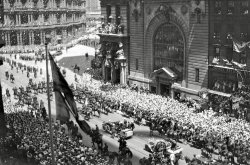
- Infrastructure: 1905
- ... this 125th and Broadway on the IRT line. Bedrock in North Manhattan was to dangerous and labor intensive to blast, so an extremely high ... signaling during the 1980s. Impressive structure.
Manhattan Street This is definitely the 125th street viaduct. We're looking ... Posted by Dave - 08/14/2012 - 10:48am -
![Infrastructure: 1905 New York City circa 1905. "Where the subway is an elevated." 8x10 inch dry plate glass negative, Detroit Publishing Company. View full size.
Does anyone knowWhy and when was the brick head house torn down?
Date of photoI'm curious about the 1905 date, as the Belasco Theater, advertised here, was built in 1907. Perhaps this photo was a few years later?
[The 1905 date is correct. The original Belasco Theatre opened in 1902. Below: Ad from September 1902. - Dave]
125th and BroadwayI do believe this 125th and Broadway on the IRT line. Bedrock in North Manhattan was to dangerous and labor intensive to blast, so an extremely high elevated was the course of action. Spent many a day working there on the signaling during the 1980s. Impressive structure.
Manhattan StreetThis is definitely the 125th street viaduct. We're looking downtown along Broadway. The cross street, Manhattan Street, is present-day 125th Street (the name changed in 1920). There's now a McDonald's on the property where the Belasco Theatre sign is located.
Found it!The building between the frame is gone, but 125th and Broadway seems to be the right spot indeed. The condition of the steel today looks rather bad, I must say.
View Larger Map
Why it's elevatedWest 125th Street actually follows a fault line. It's at a lower elevation than the streets to its north or south, so keeping the subway underground as it crosses 125th would have required a massive amount of tunneling. The result is the only elevated subway line in Manhattan, except for a short segment of the 1 Train in the very northern end of the island.
SinbadPartially obscured at the lower left of the photo is a theater poster for the show Sinbad. A quick look-up at Proquest reveals that the show opened March 13 for a week's engagement at the Windsor theater. This was after a run at the Murray Hill theater that ibdb.com says was 2/27/1905 - 3/4/1905.
An amusing court case emerged from that run in which a chorus girl was said to have attacked a midget in the cast, after he pointed a stage cannon at her. He objected to being dandled by members of the chorus.
My old neighborhood!This is old home week for me, both my birthplace (Brooklyn Navy Yard) and childhood nabe show up on Shorpy. We lived at 552 Riverside Drive from 1947 till 1955. Our building was right up the hill from this spot. This stop had great old wooden escalators in the early 50's, and big heavy wooden turnstiles that made a very satisfying KA CHUNK sound when you put your 15 cent token in and pushed through. And it had a wonderful woody smell, as well. It's all efficient stainless steel and plastic now.
When I lived there there was a Daitch Shopwell supermarket where the McDonald's now stands. And right under the escalator, on the corner of Broadway and Tieman Place, was Claremont Chemists, which I'm happy to say is still there (without its soda fountain).
And there were still trolleys on Broadway, and 125th St led down to the Ferry to New Jersey. And there was a horse drawn vegetable wagon on Broadway as well. Oh, my, the memories are pouring out!
ManhattanvilleThis is a terrific view looking north up Broadway as it crossed Manhattan Street, the signature street of Manhattanville, a once-vibrant town that is now a less distinct section of West Harlem. Except for the magnificent Manhattan Street Station seen in the photo (note the name on the wall of the masonry structure below the tracks), whose name changed in 1921, 17 years after opening.
The Belasco sign on the right is the NE corner of the cross streets. The apartment building under construction is still there, as are most of the surrounding 5- and 6-story apartment buildings that went up in 1905 and 1906 as part of the "Manhattanville Building Boom" (NY Herald) that was a direct result of the new rapid transit line.
The buildings beyond the "Sinbad" sign to the extreme left were at the juncture of West 129th Street and Manhattan Street (now called St. Clair Place and West 125th Street, respectively). Unfortunately, Columbia University just demolished them last year (2010) in the course of expanding its campus into Manhattanville.
This impressive subway structure was considered "worthy of Eiffel" when it opened in 1904. It, and the unseen Riverside Drive Viaduct, are centerpieces of the historic old New York neighborhood I discuss in my book "Manhattanville: Old Heart of West Harlem."
-- Eric K. Washington
(The Gallery, DPC, NYC, Railroads, Streetcars)](https://www.shorpy.com/files/images/4a12442a.thumbnail.jpg)
- Manhattan Center
- Taken by my Grandfather in the early 50s while he was there in the military. View full size.
(ShorpyBlog, Member Gallery) ... Posted by theirish - 11/08/2011 - 7:33am -
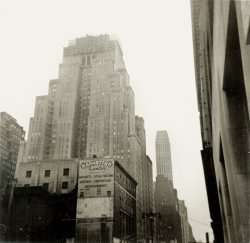
- Manhattan Parade 1
- Parade in New York City in the 1920s. The building in back is the old courthouse and post office, at the time referred to as Mullet's Monstrosity. Torn down in 1939, it was located on Broadway right by City Hall. First of five shots of the parade ... Posted by mhallack - 09/10/2016 - 9:57am -
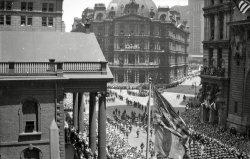
- Manhattan Parade 5
- Parade in New York City in the 1920s. Last of five shots of the parade from an envelope of negatives I bought recently. View full size.
(ShorpyBlog, Member Gallery) ... Posted by mhallack - 09/10/2016 - 9:56am -
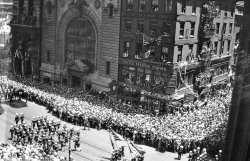
- Manhattan Parade 2
- Parade in New York City in the 1920s. Shot 2 of 5 of the parade from an envelope of negatives I bought recently. View full size.
(ShorpyBlog, Member Gallery) ... Posted by mhallack - 09/10/2016 - 9:57am -
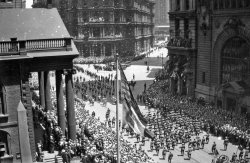
- Manhattan Parade 3
- Parade in New York City in the 1920s. Shot 3 of 5 of the parade from an envelope of negatives I bought recently. View full size.
(ShorpyBlog, Member Gallery) ... Posted by mhallack - 09/10/2016 - 9:57am -
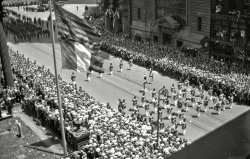
- Free Ice: 1900
- ... time as a Shorpy fan.
Melting Pot Temperatures in Manhattan will probably go over 100 degrees today. It has been in the high 90s ... Posted by Dave - 11/28/2018 - 10:09am -
![Free Ice: 1900 Circa 1900. "Heat wave. Free ice in New York." 8x10 inch dry plate glass negative by Byron for the Detroit Publishing Company. View full size.
Great TimingMy friends back East say it brutally hot just now, Hudson Valley included.
More than just comfortI would bet that most of these people are not going to use this ice for chilling their drinks. They're probably going to use it to keep their food from spoiling.
One thing about the present day is we continually go from hot to air conditioned environments during a heat wave. In New York, no matter how cold it gets outside, the subway cars are usually cooled to the point of refrigeration. This keeps our bodies from becoming acclimated to the temps. These folks have been in the heat and have become somewhat adjusted. The clothes they wear are probably all cotton or linen, both of which have the ability to wick the sweat away and help cool the body. I'm sure they're pretty miserable, but coping.
You'd get a line for free ice right nowWith temperatures hitting 101 degrees, in the middle of a l-o-o-ng week of 95+, you'll get plenty of people willing to stand in line for bags of free ice.
Ice cubes in a bowl + fan = poor man's air conditioning.
Thanks, Dave, for reminding us that some things never change, like NYC heat waves in the summertime. The children who grew up standing in those lines supported the construction of municipal swimming pools during the New Deal. They remembered!
Nostalgic and VintageI absolutely love old photographs, the older the better. You get to experience people, places and things frozen in time.
Sure this isn't Japan?The policeman looks like he's wearing white gloves. That would suck on a hot day like it appears to be in the picture.
Hot CommodityLater on, someone realized they could spritz it with food coloring and some flavored syrup and charge for it.
The Iceman (and Milkman) ComethBack in the 1940's in Newburgh NY in the midst of a summer heat wave, neighborhood kids would raid the back of the open ice delivery truck while the iceman would be tonging a block of ice to home ice boxes. Another source for kids, of small chunks of ice, was in milk delivery trucks while the milkman was delivering his wares.
Weather's nice here in Monterey.It might have gotten to 65 here today.
Staten Island FerryWhen my parents married in New York, in 1953, they stayed with a friend in Harlem. It was so hot and a neighbour was having a rent party so my parents took the Staten Island ferry back and forth all night long. Cool and quiet, compared to their friends' apartment.
I lived on City Island, in the Bronx, for two years and with no air-conditioning, and the ceiling fans not being up to the job, it was like trying to sleep in pea soup.
Trying To Imagine...what NYC must have smelled like with all of those sweating people and piles of horse manure in the streets makes me not want to go back in time to experience what is going on in the photo. This is a first in all my time as a Shorpy fan.
Melting PotTemperatures in Manhattan will probably go over 100 degrees today. It has been in the high 90s for the last few days and will be in or around the 100 degree mark for the rest of the week. There will be no free ice and the local utility, Con Ed, has started cutting back on the power so the air conditioners are not performing to spec. I think I'll go to a movie today, their sign says they're 20 degrees cooler inside. Incidentally, movie theatre air conditioning goes back to 1925 when Dr. Willis Carrier cooled the new Rivoli Theatre on Broadway.
Fishy, indeed!We are experiencing a real heat wave in New York today. I don't for a minute believe that the photo was taken in a temperature that comes close to our 100+
Look at the barefoot boys on that sidewalk -- there's your proof.
I got news for yahFree Ice? That's nothing special. Every February there is tons if it in New York. You just need to plan ahead a little.
Hats Year RoundUp until the 1950's or so, you will notice that headgear was always part of the dress code. My dad wore a hat most of the year. It had to be hot and uncomfortable.
Something's FishyI can't believe all their icemakers went out at once.They need to call the super and complain.
Take it offThey sure are wearing a lot of clothes for a heat wave. I'd lose the jackets and long sleeves.
Barefoot tykesThat sidewalk had to be hot!
HatsA few years ago I bought a straw hat and It seems to actually make you feel cooler on a hot day.
Cool LidOnly a straw hat would make sense, or maybe one of these.
Poor timingHow about some lovely pictures of deep snow, ice-covered lakes, or something to make us feel cooler in today's hot weather?
The Long Hot SummerLooks like the cop has had a long day. As hot has his uniform is, my hubby now has to wear pretty much all that, except in polyester and with an extra 35 pounds of equipment, plus a bullet proof vest. It's been hovering around or at 100 lately here in Maryland, and his vest doesn't have time to dry out from sweat one day before he puts it on the next. So next time you see a cop sitting in his car with the AC on on a hot day, think of that guy up there! He could use a little break! (I hope he got hold of some ice chunks.)
Waaaaah!I love reading about the New York heat waves with temperature in the 90s or even 101 (!). If it was in the 90s in Austin, we'd all be wearing parkas.
Most of these people want Gordon Park!As in the last picture.
Even in these Victorian times you can see signs of the heat, the cop wiping his brow, most men in the derbies have them way back on their head to let the heat out, and the straw hat man doesn't because they let heat out, just as the Mexican and South East Asian farmers learned from history.
I loved the snow cone comment, probably very right, why give the melting ice away if you can sell it!
Hot mamaSo I can see why they had the long pants, skirts and hats, but couldn't she have left the shawl off?
Hey, Austin tipster We NY/NJ SMSAers feel the same way about you guys when your highways are shut down after 4 or 5 inches of snow. We laugh at your puny "frozen precipitation levels" that seem to cause such chaos!
Have you ever been on the Lower East Side, and seen these turn-of-the-19th-century former tenement neighborhoods? They are still standing: five- and six-floor walk-ups, built with no help from Mr Otis, crowded together on narrow streets.
Even today, Austin's population density of 2600 people per square mile is less than 1/10th of New York City's (26,100). Crowding ten times as many people into every square mile raises the ambient temperature of NYC exponentially. When the weather report says "90" in a town of crowded, narrow streets with ten times as many people, it is a medical emergency.
Be grateful that, in your hometown, such temperatures make you reach for a sweater. It's not a sign of how much tougher Texans are in comparison to New Yorkers. It means that you are fortunate to live where the historical development patterns have provided you an environment where weather extremes aren't so dangerous to human health.
547Was looking for clues about the location of this picture and noticed the clothing store has "547" on the awning (alas no street name). Looking closer you can see that "547" is also written on the inside of the awning and reflected in the store window. But the reflection isn't backwards ... so perhaps it was written backwards so that people facing the window could see the non-backwards number in the reflection? Very curious.
[The "547" on the outside of the awning would be backwards on the inside of the awning because it's the same "547" showing through the canvas. - Dave]
(The Gallery, DPC, NYC, Stores & Markets)](https://www.shorpy.com/files/images/4a09036a.thumbnail.jpg)
- Chelsea Piers: 1912
- ... that name from river to river. It was among the last of Manhattan's streetcar lines to be "bustituted" in the mid-1930's. Today the ... of Scottish players.
Pier 62 On the west side of Manhattan piers are numbered by this method: the cross street plus 40. Thus, ... Posted by Dave - 01/15/2024 - 3:02pm -
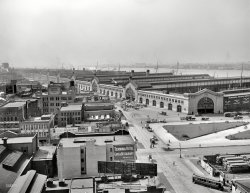
- 3 Days Cure for Men: 1920
- ... Violent thunderstorms with possible hail or gleet.
Manhattan Injection That label might be the worst thing I've read in my ... for Captain Kangaroo.
Consult your physician. "Manhattan Injection," the name and instructions notwithstanding, is "for ... Posted by Dave - 09/13/2011 - 9:58pm -
![3 Days Cure for Men: 1920 Washington, D.C., circa 1920. "U.S. Public Health Service." Dubious nostrums for, um, down there. Harris & Ewing Collection glass negative. View full size.
Interesting ingredientI notice that alcohol and opium are part of the "cure." I guess at least you "feel" better!
RegretsI knew I shouldn't have googled gleet, but it's like watching a trainwreck. I did it and I am glad I wasn't eating anything as I might have lost it! Nasty!!
Gentlemen's ClubWhat, nothing for the ladies?
Weather ForecastViolent thunderstorms with possible hail or gleet.
Manhattan InjectionThat label might be the worst thing I've read in my life.
Yikes! Did they work?I had to Google "gleet." (Note: Don't Google "gleet"!) I sure hoped these cures worked for the men. What was available for the gals? Antibiotics all around!
A ruling, pleaseIs "gleet" an acceptable word in Scrabble?
Gadzooks!Yikes! Injecting or self medicating sounds worse than an embarrassing visit to your Dr.
Huh?Inject it where?!?! I don't think so.
Shoulda read comments firstI Googled "gleet" and really wish I hadn't.
I love the progressive pictures of the cure. His gleet is so bad he can't even bring himself to brush his hair.
Yes to the Scrabble queryReaders of James Boswell's London Journal (1762-63) will be well familiar with gleet, as dear Jamie couldn't seem to go more than a couple of months or so without another bout.
BOSWELL. But by G-D, Madam, I have been with none but you, and here am I very bad.
LOUISA. Well, Sir, by the same solemn oath I protest that I was ignorant of it.
BOSWELL. Madam, I wish much to believe you. But I own I cannot upon this occasion believe a miracle.
This may be a silly question but --Why is the "1st day man" holding a pencil between his teeth?
The Third Day ManIt disturbs me that the fellow in "Day 3" is a dead ringer for Captain Kangaroo.
Consult your physician."Manhattan Injection," the name and instructions notwithstanding, is "for external use." It should not be confused with, but may well be used with, "Manhattan Internal Remedy."
In the futureour descendants will watch archival videos of Cialis, Hoodia, and Cognex commercials and think the same thoughts that this photograph invokes in us.
Biting nailsI'm assuming the nail in Day 1's teeth is to help prevent him from crying out in pain, as in biting the bullet.
The Google warnings prompted me to check Wikipedia for gleet instead, where I was subjected only to a verbal description. Thank heavens.
An Ounce of PreventionSomehow, I suspect that the people who made the Ounce Prophylactic would also be willing to sell you the Pound of Cure Injection if necessary.
Clears up your service recordIt sounds as if some of these nostrums would be useful if one had a Dishonorable Discharge, particularly one from the Foreign Lesion.
Microzone Quackery
Nostrums and Quackery, Vol 2, 1921
Microzone Medicine Company
Writes a physician:
"The enclosed envelope with contents was sent to my son, who is drafted for the Army. Evidently all of these boys are getting it. Something ought to be done to protect the boys."
The envelope contained a card on one side of which was printed a picture of the "Heart of Hot Springs, Ark.," headed "World's Garden of Health Controlled by U. S. Government." On the other side the Microzone Medicine Company of Hot Springs, Ark., advertises "the only treatment which will positively cure inherited or contracted specific blood poison permanently." Further, the recipient is told that "out of 7,000 patients who have taken our treatment … not one has failed to be cured permanently. Many were cured privately at home by mail." In addition to the card, the envelope contained two crude facsimiles of ten dollar Confederate bills, on the back of which "Microzone," the "King of all treatments for blood poison," was advertised, "$25 for full treatment."
The Microzone Medicine Company, according to material in our files, is operated by a quack, one J. M. Byrd, whose license the Arkansas authorities revoked in 1913. In a letter written in 1914 Byrd said: "I am now confining myself to the sale of a syphilitic cure … and I can make more money in that way and make it much easier than to do a general practice." At the same time Byrd was advertising a pamphlet with a salaciously suggestive title. Now, it would seem, Mr. Byrd would make more easy money by selling a fake syphilis cure to the young men who make up the National Army. Some men make a living out of war by robbing the dead on the battlefields; they at least do not impair the efficiency of the army. Other men rob the boys in khaki while they live, taking both money and health. They do this at a safe distance from the firing line and use as an instrument the United States mails.
(Journal of the A. M. A., Sept. 8, 1917.)
Of French Origin
Nostrums and Quackery, Vol 2, 1921
Restoria
"Restoria for Bad Blood" is sold by the Restoria Chemical Company of Kansas City, Mb. The label declares the presence of "alcohol, 34 per cent."— an admission that is required by the Food and Drugs Act. Restoria is sold as a sure cure for syphilis. It is "the Miracle Medicine," "the Medicine of Last Resort," it is "Safer—Surer—Cheaper than the Serum Treatments," it contains "no mercury—no arsenic, ask the druggist." No information, of course, is given as to what Restoria contains, except the information that the law demands. It is said to be "of French origin, and has been known and prescribed throughout Continental Europe for more than fifty years."
While Restoria is recommended for rheumatism, kidney trouble, lumbago, eczema, and the omnipresent "catarrh," it is especially and particularly featured for syphilis or "blood poison." Here are some of the things the booklet has to say regarding syphilis and its treatment with Restoria and by other means:
"Restoria goes to the seat of the disease. It cleanses the Blood, as it were, eradicating from it every trace of the Syphilitic virus."
"One month of Restoria treatment may be equal to the services of the most eminent specialist, for whose skill you would be required to pay hundreds of dollars."
"… to the average doctor this dreadful malady [syphilis] is only a name, and the patient is looked upon as a horrible example on whom he (the doctor) may practice and profit while he prescribes."
"The average physician is utterly incapable of handling this dreadful malady. He lacks the experience, but he will not tell you so. He will assume a knowledge he does not possess. He will do the best he can for you. He will fill you with mercury or arsenic, perhaps, and make a helpless wreck of you in time; and all the while charge you all the fee he can get."
"The unfortunate Syphilitic is considered common prey, and any physician is justified in trying anything on him, and charging three prices for the service."
Restoria was first brought to the attention of The Journal in November, 1917, by a letter from the Council of National Defense, written by the chairman of the Subcommittee for Civil Cooperation in Combating Venereal Diseases. The letter stated that the Restoria concern had had the effrontery to write to the Venereal Disease Committee of the Council of National Defense, asking for a recommendation of Restoria! More than a year later — in April, 1919 — a physician informed The Journal that there was an effort to finance Restoria, and samples had been sent to him at the request of a friend who had been invited to take some of the stock.
An unopened, original bottle of Restoria was submitted to the Association's laboratory, and tests were made to determine the presence or absence of mercury, arsenic or iodids. The report may he summarized thus:
Restoria contains no mercury or arsenic, but does contain iodid, probably potassium iodid, and calculated to potassium iodid corresponding to 1.693 grams in 100 c.c. It also contains much vegetable extractive, some alkaloidal drug, and a bitter oil or oleo resin.
(From The Journal A. M. A., Aug. 9, 1919.)
(The Gallery, D.C., Harris + Ewing, Medicine)](https://www.shorpy.com/files/images/20774a.thumbnail.jpg)
- Apocalypse Monday: 1924
- Washington, D.C., 1924. "Ford Motor Co. -- Manhattan Laundry trucks." Emblazoned with the ominous slogan WASH DAY DOOMED. ... negative. View full size.
Florida Ave. N.W. Manhattan Laundry
—With the Famous Net Bag System
1336-1346 ... Posted by Dave - 11/13/2013 - 7:21pm -
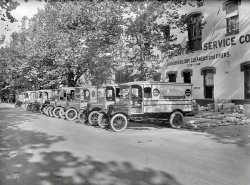
- Frosted Fifth: 1905
- ... fresh snow crunching underfoot.
Anyone who lives in Manhattan today will marvel at the attention paid in to clearing the way for ... at the curb corners.
Any Shorpsters living in Manhattan? It appears the the two buildings on the NE corner of 5th Ave and ... Posted by Dave - 07/27/2012 - 4:52pm -
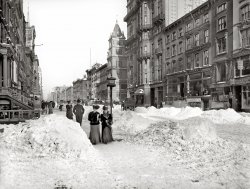
- The Flatiron: 1903
- ... a Restoration Hardware that is usually deserted.
Manhattan Traction Here's the Cable Building at Broadway and Houston Street in Manhattan. Built in 1893 to turn the cables of Manhattan's traction cars, which ... Posted by Dave - 08/05/2012 - 2:03pm -
![The Flatiron: 1903 The Flatiron Building circa 1903, with Broadway on the left and Fifth Avenue on the right, and lots of street traffic all around this early skyscraper shortly after its completion. 8x10 inch glass negative, Detroit Publishing Co. View full size.
A wonder of the ageWhat a great shot but I have to wonder; what makes all those trolley's go? No overhead wires but it seems a slot between the tracks. Cable cars?
[They're electric streetcars. The power supply is underground. - Dave]
ThanksAlways a treat to see another shot of this iconic building as it was intended to look.
What a Beauty!As much of a beauty now as it was in 1903!
Pach Brothers, PhotographersAt least five NYC locations since 1867 for these portrait photographers of some repute. The last shop closed in 1947. The studio here was 925 Broadway. The retail operation in the building was a firm called Van Gaasbeck Oriental something. The building still stands; the ground floor houses a Restoration Hardware that is usually deserted.
Manhattan TractionHere's the Cable Building at Broadway and Houston Street in Manhattan. Built in 1893 to turn the cables of Manhattan's traction cars, which first started running in the mid-1880s. The basement housed the steam engines and cable wheels.
[An impressive infrastructure that was phased out in favor of electric streetcars in the early 1900s. - Dave]
Have You Noticed?In just about any early photo of the Flatiron Building you can see one or more brave souls roaming around on the lower ledges. I suppose today that'd be the Designated Smoking Area!
Cable cars, absolutely!The streetcars visible are all cable cars.
The Metropolitan Street Railway main line ran along Broadway from Battery Place up to 7th Ave, and then along 7th to 59th Street at Central Park. One of its branches ran along 23rd Street to Lexington Ave (right in front of the Flatiron here) and up to 105th street.
[These are electric streetcars. The traction line on Broadway was converted to electric power in 1901. Below, news item from May 27, 1901. - Dave]
Pach Brothers StudioActually Pach Brothers Studio continued operation (at a different location until 1994. I took portrait classes from the last owner, Oscar White. Interesting man, he did presidential portraits form either FDR or Truman to at least Johnson as he brought that portrait into our class to show us. I took his classes in the mid-1970s to late 1970s. More information is available here.
(The Gallery, DPC, Flatiron Building, NYC, Streetcars)](https://www.shorpy.com/files/images/4a10928a-flatiron.thumbnail.jpg)
- Seward Park Sequel: 1903
- ... the purchase of Alaska in 1867.
The park that ate Manhattan ... or at least a goodly potion of the Lower East Side: it's quite ... The last horsecar line on the Bleecker Street route in Manhattan lasted until 1917, while Pittsburgh had this form of transit on Sarah ... Posted by Dave - 03/11/2022 - 2:42pm -
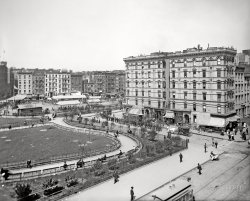
- Hamilton House: 1910
- Manhattan circa 1910. "U.S. Custom House, New York, N.Y." The Alexander ... Posted by Dave - 02/05/2024 - 11:07am -
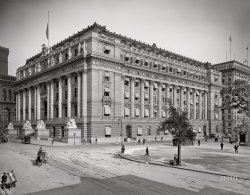
- Hanover National Bank: 1903
- Lower Manhattan circa 1903. "Hanover National Bank Bldg., New York City." 8x10 inch ... of the buildings in the 1903 photograph exist today.
Manhattan Life Insurance Building To answer Timz's question, the building under construction on Broadway is the Manhattan Life Insurance Building, designed by Kimball and Thompson and built ... Posted by Dave - 10/12/2021 - 1:28pm -
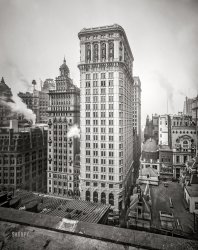
- Sincere Market: 1958
- ... hurt! 4x5 News Archive negative. View full size.
Manhattan I believe that is a Kaiser Manhattan parked to the left and above the right rear fender of the Ford police ... Posted by Dave - 09/23/2015 - 9:41pm -
![Sincere Market: 1958 Oakland, Calif., circa 1958. "Bread truck collision." But so what. We need to make sure the Hot Sausage isn't hurt! 4x5 News Archive negative. View full size.
ManhattanI believe that is a Kaiser Manhattan parked to the left and above the right rear fender of the Ford police cruiser. The rear window widow's peak is the revealing detail.
[The car is a Lincoln, and that's a reflection. - Dave]
Said the truck driver:This is the last thing I kneaded, it's going to cost me some serious dough, the driver of that car is a heel, my insurance rates will probably rise.
Can't Be OaklandNo wrecked Olds!
Point of impactWas the Mercury airborne when it hit the bread truck? The point of impact is above the height of the headlights.
Said the driver of the carAt yeast I am not seriously hurt.
Why is it so many buy Kilpatrick's?Because it's fresher and tastes better!
By the wayCan I just say how awesome these Oakland accident pics are?!
Sincere MarketYour photographer's beat seems to have concentrated on the African-American section of Oakland. Oakland, and especially ultraconservative Berkeley, were de facto segregated and overtly racist cities in the 1950s. In a previous picture one could just make out the segregated "Rex" theater. The African-American radio station was KWBR, whose afternoon show was (I am not making this up) called the "Sepia Serenade." Record stores filed their R&B under "Race Music," in search of which I spent a lot of time in this section of town.
One warm summer day I pulled up to a stoplight on Telegraph Avenue in Berkeley next to a Buick driven by a typical pearl-bedecked Berkeley matron, my radio blaring one of "Big Don" Barksdale's choices (I think it was Dr. John's "How Come My Dog Don't Bark When You Come Round," still a favorite). The lady gave me a horrified look and despite the temperature rolled her window up.
Blackout ModelThe car on the right is a 1942 Chevrolet that may have been built just before all car production was ceased before WWII. Most of the bright trim was painted a contrasting color instead of being chromed. Some of the trim on this car is chrome. Possibly it was changed after the war? These cars are quite collectable today.
1038 24th Street
I used to work in a bread storeI was a pilot. Took bread from one corner and piled it up in another.
(with thankx to Curly Howard)
Got tired of the doughSo went on the loaf.
Said the truck driverDough!
Kids will be kids!Love the 3 kids goofing it up on the hood of the crashed car (visible through the windows)! Goofing around is timeless!
(The Gallery, News Photo Archive, Signal 30, Stores & Markets)](https://www.shorpy.com/files/images/SHORPY-694.thumbnail.jpg)
- Windows on the World: 1938
- ... Administration. View full size.
Mooners Over Manhattan Ralph, Alice, Ed and Trixie would probably take umbrage at these ... the Bensonhurst section of Brooklyn. East 63rd Street in Manhattan is a world away from Brooklyn, especially in the days of the ... Posted by Dave - 04/18/2019 - 9:56am -
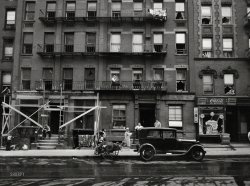
- Winter Palace: 1933
- ... to follow to find the Wizard. Well set and framed!
Manhattan Simply put, one of the most glorious urban landscapes on the ... Posted by Dave - 07/17/2012 - 10:26pm -
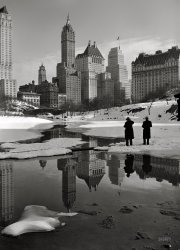
- The Newsroom: 1942
- ... don't judge.
And Now, The Weather NOAA weather for Manhattan shows a high of 93 on 9/3/42. Might explain the matted hair, ... Posted by Dave - 11/17/2023 - 11:09am -
![The Newsroom: 1942 September 3, 1942. "New York, New York. Newsroom of the New York Times newspaper. Right foreground, city editor. Two assistants, left foreground. City copy desk in middle ground, with foreign desk, to right; telegraph desk to left. Makeup desk in center back with spiral staircase leading to composing room. Copy readers go up there to check proofs." Medium format acetate negative by Marjory Collins for the Office of War Information. View full size.
The Front Page's Back RoomNot very glamourous, is it?? Even by the standards of the day, I would have expected something more impressive for the Paper of Record. But perhaps our expectations are tainted by modern conditions: whereas today the 'Times' may be NYC's only broadsheet, in 1942 there were a multitude - Journal-American, World-Telegram, the Sun -- some of which eclipsed the Times in circulation; but the real competitor for the quality reader was the Herald-Tribune. I've heard it posited that WWII is what earned the Times the final victory lap: it used its war-ration reduced pages to emphasize news, whereas the HT gave the edge to advertising. I don't know how true this is, but it's a great story.
Safe pre-OSHA WorkplaceLooks like way back then they didn't need an agency of the Federal Government to codify or remind them of the dangers of falling light globes (I didn't even know that was a thing.) Their safety conciousness even extended to the film used to record their workplace for posterity. Which begs the question, what happened to the guy at front left.
Paper cut? Malingerer? Bar fight?
Phones?I only see three telephones in that whole office! How can they get any work done?
I'm sure that everyone they would've needed to speak with was within shouting distance. Amazing how efficient things were back then!
No cubicle walls either.
Makeup desk???What, are they planning early for TV?
What a classic case of industrial chic, even with wire cages on the lamps!
Front Page Headlines September 4, 1942 New York TimesUS FIGHTS NEW LANDINGS IN SOLOMONS; SINKS CRUISER, 4 OTHER SHIPS IN PACIFIC; NAZIS ADVANCE NORTH OF STALINGRAD
Marines Meet Foe
Franco Shakes Up Cabinet, Ousts Suner and 2 Others
Allied Blows Force Rommel to Withdraw at Some Points
President Warns Youth to Choose Death or Freedom
Submarines Sink 5 Japanese Ships
Astor Real Estate Policy Shifted to Meet New Order
British Bombers Sear Karlsruhe; Sinclair Urges Sabotage in Reich
OPA to License All Meat Packers and Wholesalers in Control Move
The Copy Boywould take a writer's finished typing when the writer held it aloft saying a bit more than audibly, "BOY!" In later times this was changed to "KID!"
Got that from a WSJ veteran.
Why the cages around the lights?What do they need protection from?
SPIKE THAT STORY! NOT my hand!Copyboy! Get me OSHA! And having worked in such dangerous places in the 1960s ...
Light cagesWhy are there cages around the ceiling lights? All I could think of was that the composing room upstairs creates enough vibrations to occasionally knock a light fixture off its ceiling mount, and the cages protect those below.
Typewriters?Interesting. When I worked in a newsroom in the 70s it wasn't much different from this except everyone had a typewriter. I wonder why there's not a single one visible in this photo.
[You don’t need a typewriter to edit. Just a grease pencil. - Dave]
Not many visorsThis most be towards the end of the era for visors. Green eyeshades or dealer's visors are a type of visor that were worn most often from the late 19th century to the mid-20th century by accountants, telegraphers, copy editors, and others engaged in vision-intensive, detail-oriented occupations to lessen eye strain due to early incandescent lights and candles, which tended to be harsh (the classic banker's lamp had a green shade for similar reasons).
Wire mesh around the lights??What is that for. Oh, and that caricature, so not politically correct today.
Memo SpikeThat Assistant put his hand through the CE’s memo spike again.
Or maybe the editor is a very, very stern taskmaster.
Back in the day..Bill spikes, stick telephones, eye shades, rubber stamps, oak office chairs, pipe smokers.. all of an era.
Can anybody identify the round white things with the little handle sticking up?
[Gluepots. - Dave]
And the cages on the light fixtures — did things get rough in that room from time to time???
Times of ...Natural human data processing power.
Light Globe Cages?Not sure what the well thought out and professionally made wire cloth covers on the lights are all about. I guess it has something to do with being at war???
Grandpa, tell me 'bout the good old daysKind of depressing once you take it all in, a newsroom entirely staffed by men, plus the pipe smoking, the anti-Japanese propaganda poster, etc. It really is true that "The past is a different country. They do things differently there."
So many wonderful things to see from the old timesThe guy smoking a pipe, The candlestick telephones too. The wire cages on the light fixtures are also strange. Overkill, I would say. But it's a delightful photo of the past.
Shorpy logoIn an early comment below (“Safe pre-OSHA Workplace”), M2 writes, “Their safety consciousness even extended to the film used to record their workplace for posterity.” So I scrutinized the right edge of the photo, my head tilted down and to the right, to read: “EASTMAN—SAFETY—KODAK 101 SHORPY.” Very clever!
SaunaThese men don't need to go to a steam bath - it looks like their work place is already very hot and humid. Each of those caged ceiling lights is probably putting out 200 watts of heat, plus all the body heat of the men. Their shirts look very moist. The large metal ducts on the ceiling might only be for exhausting smoke and heat from the room rather than forced air conditioning. I would love the see a photo of the cord switchboard with operators connecting the candlestick telephones.
Not a coffee cup in sightCoffee rationing in effect already?
SwelteringThe high temperature in New York that day was 93 degrees -- no wonder they all look so sweaty.
Depressing? Why so Karen?Perhaps a history book is not in your future, or you'll be very very depressed. In other words. Lighten up.
Sweet Smell of the City DeskInhale deeply and let’s go back in time and take an olfactory tour of the newsroom. The first thing that hits you as you enter the room would be the tobacco smoke. I count at least three pipes and a cigarette, but no ashtrays. In a closed room the smoke and ash odor would be the first thing you notice. Weather archives report that the temperature reached 93 degrees F. in New York City on September 3, 1942 – near record heat. The next thing you’d notice would be man-sweat and hair tonic. Vitalis and Brylcreem and Murray’s Pomade each had a distinctive aroma and the miasma rising from those guys must have been remarkable.
Add to the vaporous atmosphere the smell of printer’s ink, gluepots, rubber-gum erasers, pencil shavings, leather satchels, and freshly developed photographs. Even though the clock says 9:20 AM perhaps you'd catch a whiff of flask-borne whiskey and, judging be the unshaven assistant city editor in the foreground, maybe the scent of monkey blood from his wound dressing. I’ll bet the gent in the eyeshade has a Limburger cheese and onion sandwich in a paper bag.
You can exhale now.
Goober Pea
Where's Hildy?This makes me want to watch "His Girl Friday".
Right off The Front PageThe movies from the 1930s led me to expect many more typewriters and whiskey bottles. Also, a sassy gal Friday.
Walk in their shoes"Nothing is more unfair than to judge the men of the past by the ideas of the present. Whatever may be said of morality, political wisdom is certainly ambulatory".
- Denys Arthur Winstanley
I'm with Al Bear I always love these photos of how things used to be in newsrooms, offices, labs, etc. and I'm especially intrigued by wartime home front photos. It's really easy for some to hold the past up to today's politically correct standards, but perhaps one of two of these newsmen lost a son or maybe even a daughter at Pearl Harbor or Midway. Maybe they have a son who recently landed at Guadalcanal. And perhaps there are women who are working in this environment but just happen to be out of the photo at the time. You don't know for sure, so don't judge.
And Now, The WeatherNOAA weather for Manhattan shows a high of 93 on 9/3/42. Might explain the matted hair, glistening foreheads and less than crisp work shirts.
The Hot SeatNew York in September, no A/C, everybody packed in like sardines ... no wonder everybody looks sweaty!
I too pictured a lot more typewriters.
9:20 am ... or pm?The previous shot of the wire service machines shows that it's pretty clearly dark outside (the left-hand window is open without whatever-it-is that's in the right hand window opening).
It seems to me that this is more likely the evening of September 3rd, 1942 rather than the morning.
[The Times is a morning paper, so yes, it's night. - Dave]
Norman Rockwell PhotographIf Rockwell was a photographer he'd have taken this image.
So full of action and detail. Those head visors, the not-paperless-office, the spiral staircase and all enveloped in that amazing masonry and concrete room.
Those paper spikes were dangerous, so sharp that a careless hand could easily get a nasty wound (another reader has picked up a suspicious wound). Never mind that the spike might just go through and destroy a very important word.
(The Gallery, Marjory Collins, NYC)](https://www.shorpy.com/files/images/SHORPY-8d08925a.thumbnail.jpg)
- Lloyd Davis: 1913
- ... after four years in New Haven to take job in Lower Manhattan. Evidently a newsie. Talks in gibberish: 'I sell paper on the Street. ... site, and that's no April Fool.
Lloyd of Lower Manhattan The waif of Wall Street.
Hilarious!
Lloyd the Newsie ... Posted by Dave - 09/09/2011 - 6:05pm -
![Lloyd Davis: 1913 April 1, 1913. "Lloyd Davis, 125 Riverside Drive. Says 22 yrs. old but it is doubtful. Quit schooling after four years in New Haven to take job in Lower Manhattan. Evidently a newsie. Talks in gibberish: 'I sell paper on the Street. Bonds, convertible debentures, securities.' Smokes, visits saloons. Goes to houses in the District: Goldman Sachs, J.P. Morgan. Makes fifty dollars a day." Photo and caption by Lewis Wickes Hine. View full size.
Too Funny!"Talks in gibberish" -- I'm inclined to agree!
Wonderful site, and that's no April Fool.
Lloyd of Lower ManhattanThe waif of Wall Street.
Hilarious!
Lloyd the NewsieWow. A Lewis Hine parody! I count six jokes in this caption.
Gibberish?While it is certainly possible that Mr. Davis was fabricating his job and income (Hine may have been following cues such as Davis's home address and his dress for additional insight), there is nothing nonsensical about the claim to "sell paper on the Street. Bonds, convertible debentures, securities." That job description exists in pretty much identical words today.
The Wizard of Wall StreetUh, folks, let's consider Lloyd's talents for a moment and pause to remember today's date. What often happens on the first day of April? Right. This is a fun spoof and it seems many visitors fell for it. Good job, Shorpy staff!
LloydIt's funny, so many Shorpy pics have annotations of newsboys pretending to be way older than they are - and here's this guy trying to be younger.
[Odd, isn't it? - Dave]
D'oh!Was the joke his, or yours?
[This is actually a National Photo picture from Washington, D.C., circa 1920. The subject is one Lloyd Davis, although I have no idea who he was. - Dave]
(The Gallery, Lewis Hine, NYC)](https://www.shorpy.com/files/images/19639u.thumbnail.jpg)
- Corn Exchange: 1951
- ... ornaments in the upper branches.
An Achene Matures in Manhattan The branch with the apparent Christmas ornaments belongs to a ... to this narrative.) In 1996, Chemical acquired Chase Manhattan and adopted Chase's more well known identity. You will notice that ... Posted by Dave - 02/24/2015 - 1:32pm -
![Corn Exchange: 1951 New York, 1951. "Street scene, Corn Exchange Bank." Sharing the spotlight with two Sanitation Department trucks. 4x5 negative by John M. Fox. View full size.
Double ParkedI'm drooling over that Woody, double-parked. Wishing I could go back in time to take a little spin around that New York block.
The paint store building is still thereThe two to the left are gone.
View Larger Map
Before direct depositMust be payday! City employees, business people and others heading to the bank, some even double parked.
Dream onThe tree in the foreground has what appears to be a couple of Christmas ornaments in the upper branches.
An Achene Matures in ManhattanThe branch with the apparent Christmas ornaments belongs to a sycamore, a classic urban street tree. The balls are achenes that surround a single seed.
RoundedCars were softer then.
Photo dateThe Hudson parked at the far curb, center of photo is a 1952 or 1953 model by its side trim so if this is 1951, it is late in the year and the new cars have been introduced and are on the streets.
[The license plates say 1951. - Dave]
Paint truckBack in the sixties, one of the parents who drove in the car pool that transported us to our school across town was a house painter who had a truck very similar in type and vintage to the Craftsman vehicle. Same lack of windows along the sides in the rear. We sat in the back on two benches running the length of the space, facing one another, sharing legroom with paint cans and ladders. Nothing was bolted down, and there were no seatbelts. When Mr. Blum braked suddenly, we all got a bit jostled, but no one ever got hurt and it was definitely the most fun ride of the week.
Corn Exchange>ChaseThe Corn Exchange Bank was founded in 1853. In 1954, it merged with Chemical Bank and was called Chemical Corn Exchange. In 1959, it merged with NY Trust and dropped the "Corn Exchange," becoming just Chemical Bank. (Other mergers occurred not necessary to this narrative.) In 1996, Chemical acquired Chase Manhattan and adopted Chase's more well known identity. You will notice that the building currently occupying the site of the Corn Exchange is a Chase Bank. The Corn Exchange Branch down in the Village on Grove Street is also now a Chase Bank.
(The Gallery, Cars, Trucks, Buses, John M. Fox, NYC, Stores & Markets)](https://www.shorpy.com/files/images/SHORPY-230-03.thumbnail.jpg)
- Three Shot, Two Die: 1910
- ... driver was doing about 50mph though.
I'll take Manhattan And tell me what street compares with Mott Street in July, ... Posted by Dave - 09/09/2011 - 6:39pm -
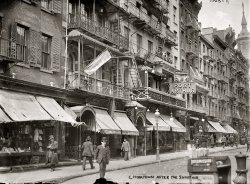
- Seagram: 1957
- ... photo of Marilyn Monroe with her dress blown up was taken. Manhattan -- something happened almost everywhere.
Manhattan Tic-Tac-Toe What's with the markings on the windows of the three ... Posted by Dave - 07/31/2012 - 6:35pm -
![Seagram: 1957 New York. January 23, 1957. "Seagram Building, Park Avenue. Oblique view from northwest." Large-format negative by Gottscho-Schleisner. View full size.
Bright Lights, Big CityAs a contractor in NY I have spent many days in this building and even though most people would pass it by and consider it in the same era as multiple other NYC buildings the mechanical infrastructure was decidedly from a past time. On another note the mostly underrated original GE building with its Deco crown is visible to the Seagram's right also a few blocks down is the Waldorf. Of interest to me at least the very Deco park ave light poles are still up with the original mercury vapor luminaires, also the last of the "greenies" two-light cast iron traffic poles are still in the median. I work for one of the companies that maintain and install NYC traffic and street lights.
Watershed Building1st "curtain wall" constructed building in US? World?
[The first curtain-wall building in New York was 1952's Lever House. Earlier examples elsewhere in the U.S. go back to the turn of the century. - Dave]
Four Seasons restaurant is in the 51st Street side of the building. If you keep walking east on 51st and get to Lexington Avenue, that is where the famous photo of Marilyn Monroe with her dress blown up was taken. Manhattan -- something happened almost everywhere.
Manhattan Tic-Tac-ToeWhat's with the markings on the windows of the three buildings at left? At first I thought all the X's were an indication the buildings were marked for demolition but some of the smaller windows have a pattern of X's and O's. Anyone know the significance?
+53Below is the same view, south from 53rd Street, taken in April of 2010.
Thoroughly ModernThe Seagram Building is a remarkable piece of architecture in its own right, but it also served as the turning point for several architects (including Philip Johnson) and was a prototype for many of Mies van der Rohe's building in the 1960s and '70s. Chicago, Montreal and Toronto all have Seagram Building "clones."
Xs on WindowsAn "X" pattern of tape (masking or duct) is often placed on window panes to reduce the possibility of the glass shattering when being removed. In this case, possibly it was done because of vibration caused by the construction of the Seagram Building? And the one on the far left, fancifully turning the small windows into tic-tac-toe games as a sly reference to that procedure?
World's most overrated buildingYes, it has better proportions and better materials than most modernist office towers, but that's like saying a particularly nice coat of fur makes one rat more attractive than other rats. At the end of the day, it's still a rat.
It's cold and dehumanizing, removed from street life by an unused plaza and windows that cannot open. The ceilings are low. The fluorescent lights are oppressive. The orange tinted windows make everyone inside look jaundiced.
The perpetual praise it gets from architects and critics — it routinely ranks among the ten most celebrated buildings of the past century — shows how barren those professions still are and why we are utterly incapable of building new environments that regular people love as much as those that predate WWI.
[I've visited the Seagram Building and the Four Seasons restaurant a number of times. They still count among the higher attainments of American civilization. - Dave]
The liquor motto:"Booze Builds"
"Curtain Wall" BuildingsThe term "curtain wall building" is misleading, because the curtain wall was developed hand in hand with the structural innovation called the "skeleton frame" - which was developed in Chicago in the 1880s. Early skyscrapers had curtain walls made of brick, stone, and terra cotta; these curtain walls were not self-supporting but rather "hung" from the skeleton frame (usually iron, steel, or later reinforced concrete). The first skeleton frame building in New York was the Tower Building at 50 Broadway (Bradford Gilbert, architect, built 1888-1889, demolished 1914); this was exceptional because skeleton frame construction was not permitted by the New York City Building Code until 1892. The use of metal and glass for curtain walls was introduced by Pietro Belluschi in the Equitable Building in Portland, Oregon (1944-1947). The idea for the metal and glass curtain wall is generally attributed to Ludwig Mies van der Rohe. He designed theoretical projects for such buildings in Berlin in 1921 and 1922, but his first built examples were two apartment buildings in Chicago at 860 & 880 North Lake Shore Drive (built 1948-1951). In the Seagram Building, Mies adapted his design for 860 & 880, with one major change: the mullions on the facade are not steel, but bronze.
(The Gallery, Gottscho-Schleisner, NYC)](https://www.shorpy.com/files/images/5a24904u.thumbnail.jpg)























